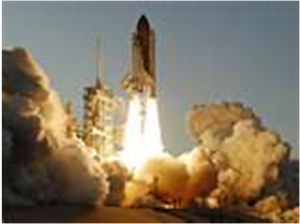by Dale Elizabeth Corey
 “8, 7, 6, 5, 4, 3, 2, 1, 0 … and liftoff for the final launch of Endeavour, expanding our knowledge and expanding our lives in space.” On Monday, May 16, 2011, Space Shuttle Endeavour (Shuttle Transportation System: STS-134) was launched at 8:56am on its last and final mission from Kennedy Space Center, Florida.
“8, 7, 6, 5, 4, 3, 2, 1, 0 … and liftoff for the final launch of Endeavour, expanding our knowledge and expanding our lives in space.” On Monday, May 16, 2011, Space Shuttle Endeavour (Shuttle Transportation System: STS-134) was launched at 8:56am on its last and final mission from Kennedy Space Center, Florida.
Central Florida is considered “Lightning Alley” because it experiences the highest lightning activity in the United States. Any lightning-related data that would have impacted STS-134’s launch commit criteria for Kennedy Space Center on May 16th would have been provided by the 45th Weather Squadron. The 45th operates the Four Dimensional Lightning Surveillance System (4DLSS), the Cloud to Ground Lightning Surveillance System (CGLSS), the Launch Pad Lightning Warning System (LPLWS, a network of 31 surface electric field mills), and the National Lightning Detection Network (NLDN). These systems help to determine whether lightning might affect ground or vehicle systems.
Prior to the STS-134 launch, the possibility of thunderstorms had been anticipated in the area that did not occur. Therefore, a “GO” was given for launch for weather! It should be mentioned that not only are there weather concerns during launch for Kennedy Space Center but also the Transoceanic Abort Landing sites (TAL) weather sites.
As the STS-134 launch day loomed, meteorologists spent their time evaluating whether severe weather systems would be a concern (i.e., electrical energy). A severe weather thunderstorm is defined as having the potential to produce winds “50 knots or greater, hail and/or tornadic activity” (Voorhees, 2011).
If a severe weather event occurs prior to launch, the shuttle vehicle and launch pad is inspected for damage. Lightning data, when it is collected, is evaluated to determine if any damage has occurred to the shuttle and/or the launch pad. Close lightning strikes can be cause for walk-downs or retests.
To help safeguard against lightning strikes at the launch pad, protection at the launch pad consists of ground wires and a lightning rod for the mast, as well as grounded structures on the launch pad and storage tanks.
The threat of lightning and/or electrical fields (with triggering potential) prior to launch can block a launch (Diller, 2003):
- “Tanking will not begin if there is forecast to be greater than a 20% chance of lightning within five nautical miles of the launch pad during the first hour of tanking.
- A launch is cancelled if lightning has been detected within 10 nautical miles of the pad or the planned flight path within 30 minutes prior to launch.
- The one-minute average of the electric field mill network may not exceed -1 or +1 kilovolt per meter within five nautical miles of the launch pad or the lightning flash at any time within 15 minutes prior to launch. This field mill criteria becomes -1.5 or + 1.5 kilovolts per meter if there are no clouds within 10 nautical miles of the flight path except those which are transparent.
Other weather-related events can affect the launch commit criteria. Cumulus clouds that are too tall can trigger a lightning strike due to elevated electric fields. Other rocket launches (Delta, Atlas, and Titan) in the Kennedy Space Center area can trigger lightning as well.
We will be watching with extreme emotion on July 8, 2011, the launch date scheduled for the end of America’s space shuttle program. It will be a very sad day.
References:
Diller, George. Space Shuttle Weather Launch Commit Criteria and KSC End of Mission Weather Landing Criteria. Accessed 23 May, 2011. http://www.nasa.gov/centers/kennedy/news/releases/2003/release-20030128.html.
Flinn, Frank. Lightning Reporting At 45th Weather Squadron: Recent Improvements. Access 24 May, 2011. http://www.vaisala.com/Vaisala%20Documents/Scientific%20papers/12.Flinn,%20Roeder,%20Buchanan.pdf.
Voorhees, Carla. Countdown to Endeavour: Lightning Protection Is a Must (Photo courtesy Kennedy Space Center Public Affairs).
Accessed 23 May, 2011. http://science.dodlive.mil/2011/05/15/countdown-to-endeavour-lightning-protection-is-a-must/.

Comments are closed.